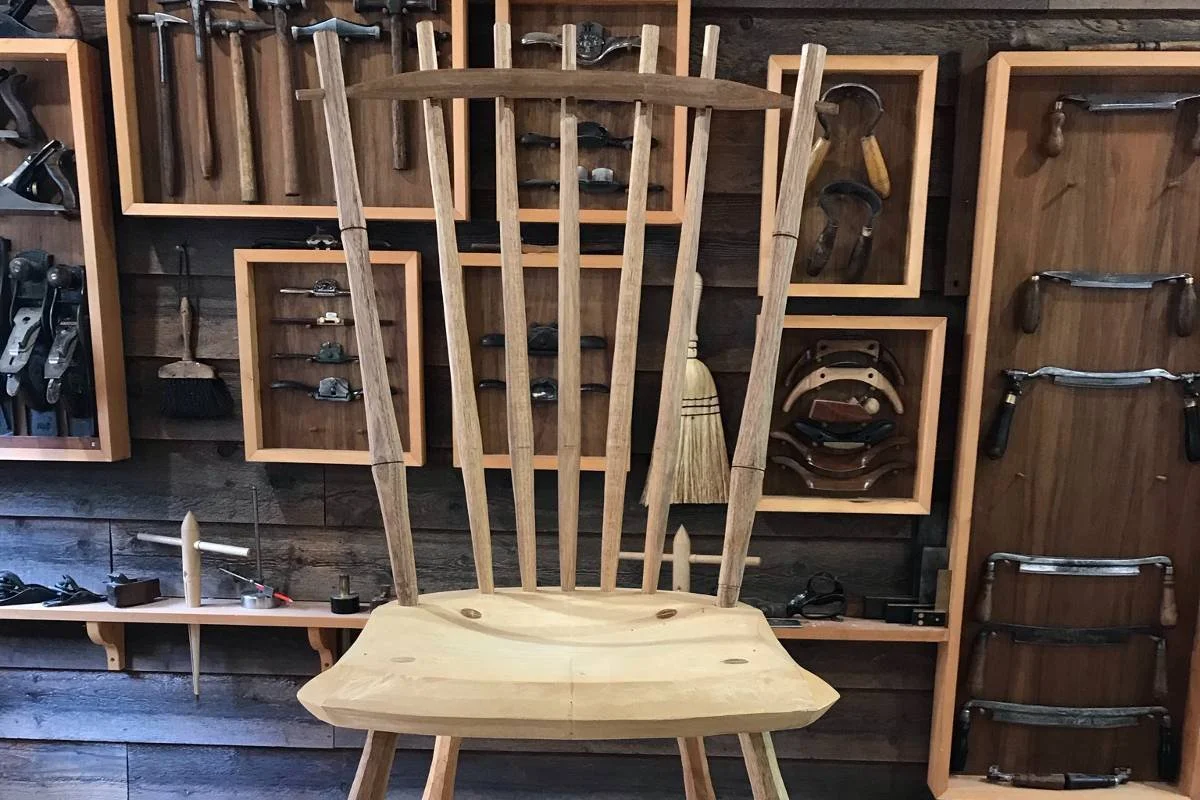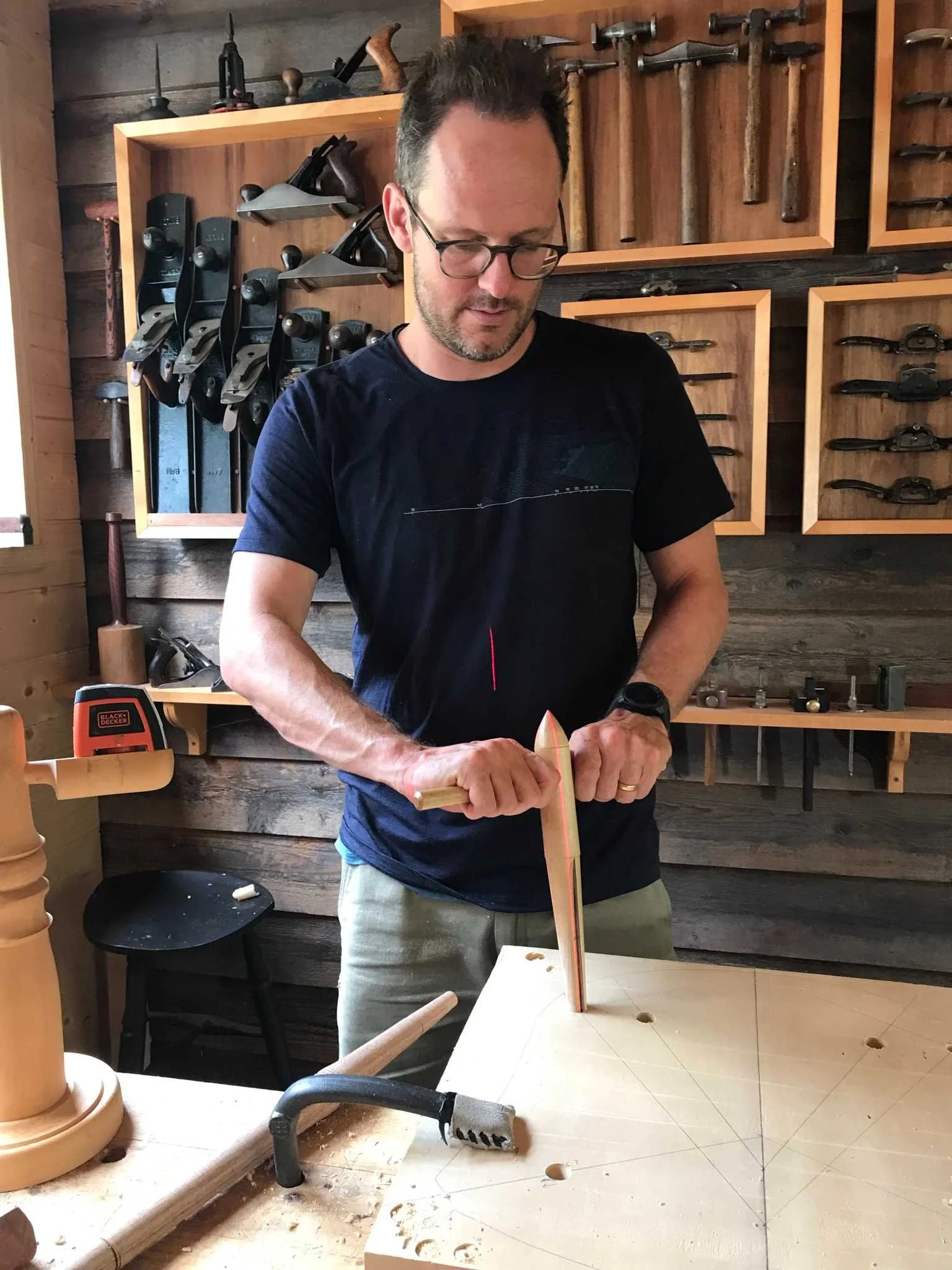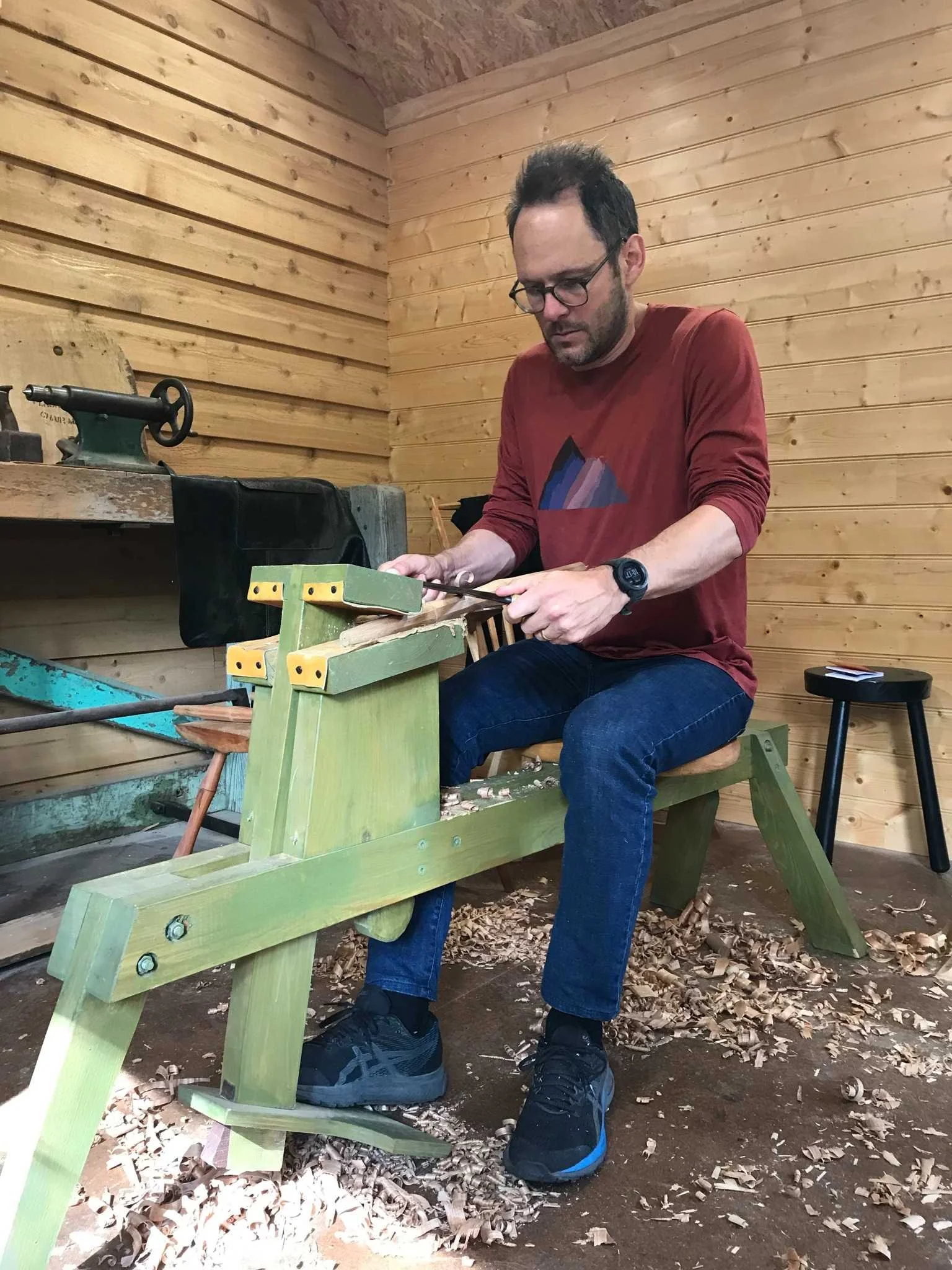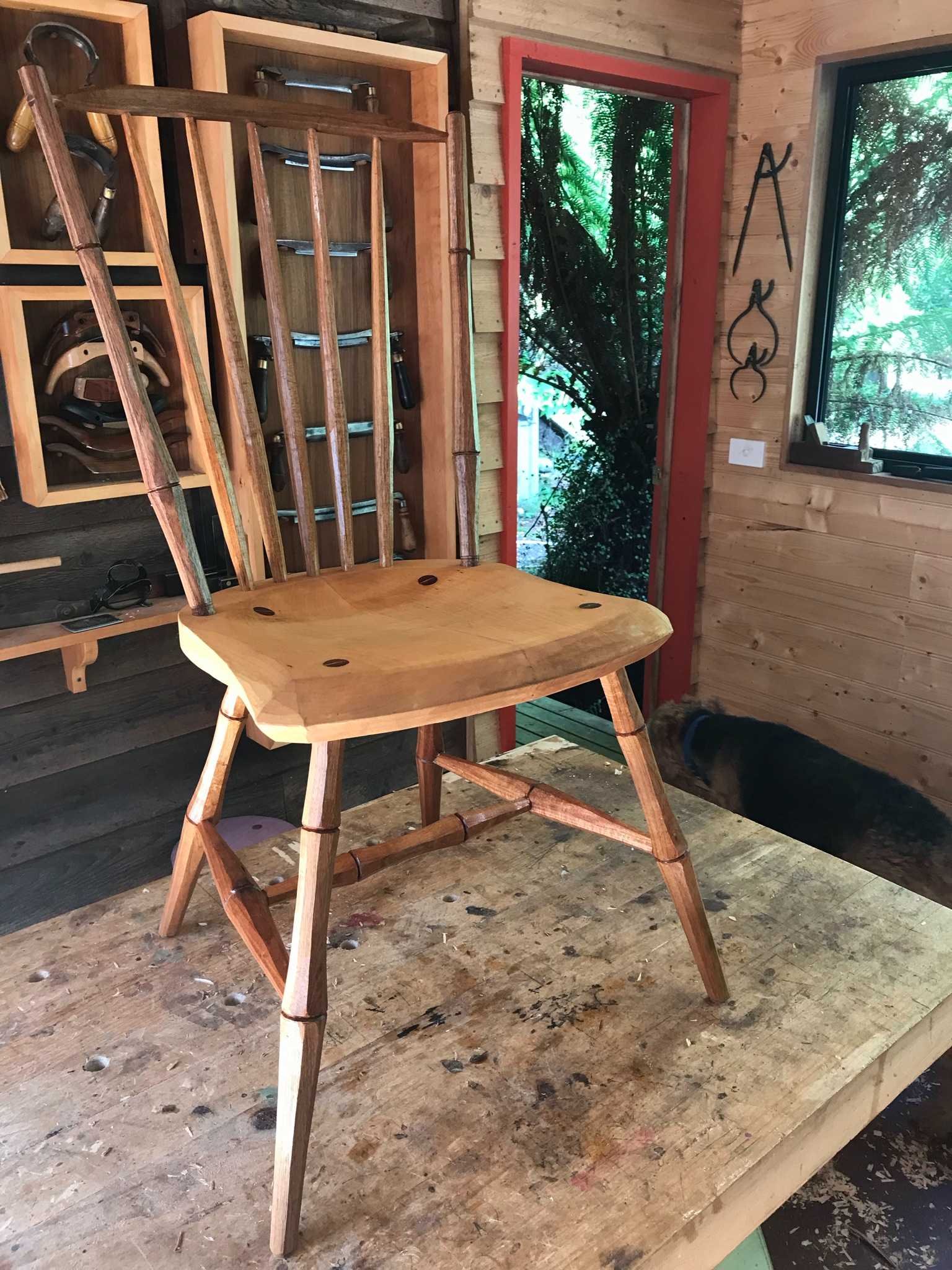Straight From the Horse’s Mouth: Windsor Chairmaking in Tasmania – by Dan Dwyer
ISLAND | ONLINE ONLYIn February 2022, I spent an enchanted week in the Derwent Valley with master chairmaker, Jon Grant. Jon, a former TAFE manager, lives with Stanley, his rambunctious yet lovable Airedale Terrier. I had come to Jon from Melbourne to learn how to use hand tools. I wanted to lessen my reliance on furniture designed to fail and be discarded. Jon offers a five-day course on how to make a democratic chair, a Windsor side chair designed by Tennessee chairmaker Curtis Buchanan.
“The democratic chair is designed to be made with a small number of hand tools, hence democratic.”
The democratic chair is designed to be made with a small number of hand tools, hence democratic. If a student learns this chair, they can make more complex Windsor chairs. ‘It wouldn’t be a Windsor chair without a bit of blood on it,’ Jon said, as we gazed at my bloodied thumb, the victim of a Japanese handsaw. I was within an hour of finishing the chair, but now I had to pause to bandage my sawn appendage. As I stemmed the flow of blood with one plaster, and then another, I grinned at Jon, ‘There will be blood.’
One wall of Jon’s workshop is adorned with century-old American and English tools divided into wall-mounted boxes. Bench planes, hammers, drawknives, scorps, spokeshaves and travishers, among many other tools, are within reach of the workbench. There is the obligatory cast-iron Scandia stove to ward off the Tassie cold. ‘I used to teach classes in my kitchen,’ Jon said, as we ate one of his famous homemade muffins. ‘People said, Jon, you’re the only person we know with a workbench inside the house.’ Jon has since relented to convention and built a workshop for his classes, much to Stanley’s dismay.
On the first day, Jon led me to the woodpile in the paddock behind his house. Jon buys the blackwood in logs from both government and private dealers. To split out the pieces, Jon took a sledgehammer and wedges. Soon, with a French froe and a mallet, we split the wood still further. ‘These blackwood pieces will be used for the crest, legs, posts and spindles,’ Jon said. Jon pointed to the wet shimmer of the freshly split ‘green’ blackwood. We were working with greenwood, wood that has not yet dried and is ideal for carving with hand tools.
“Back in the workshop, Jon explained the various parts of the democratic chair. His was a black-over-cherry-red painted example, which I dubbed the ‘burnt offering’ for its volcanic red lines.”
Back in the workshop, Jon explained the various parts of the democratic chair. His was a black-over-cherry-red painted example, which I dubbed the ‘burnt offering’ for its volcanic red lines. Jon laid a hand on the curved top of the chair, the backrest, called the crest. The crest receives the spindles from the seat, the spindles being the delicate rods or fanning backbone of the seat. The posts bookend the spindles, completing the backrest at either side.
Jon no longer needed Curtis’ blueprint, aside from the seat pattern, as he had committed the plans to memory. We started by straightening the jelutong seat using the scrub plane and winding sticks, two very important skills. Jon had glued two jelutong pieces together, and these were of slightly different heights. I needed to reduce the pieces to a uniform height. ‘The idea is to be methodical, and use long, even strokes,’ Jon said. He took the plane and, using his whole body, rocked the tool across the surface. ‘Like a lawnmower,’ I said, instantly regretting my comment.
The most important skill was learning to ride a horse. No, not the equine variety, but a shaving horse. This ancient nag is a combination vice and workbench. The shaving horse has a seat and a clamp to hold the wood so the worker has both hands free for tool operation. Seated, I had both feet on a foot-activated clamp that held a spindle in place. I used a drawknife to shape the blackwood. The first two days of the course were about building confidence and skill with the drawknife, a blade with a handle at either end that you pull toward your chest, shaving the wood clamped in the horse’s mouth.
In those five days with Jon, I had plenty of time in the saddle. The first task was to shape the crest. Next were the spindles. I kept dragging the drawknife with my left hand, holding it too high on the blade and ignoring the handles. ‘You’ll have to be able to use the drawknife to finish the chair,’ Jon said. I had sweat pouring down my back in the 30-degree workshop, burning hot for Tasmania. I thought about coming home with a pile of blackwood sticks, defeated.
Jon selected a smaller drawknife from his wall-hung selection of ten blades. I was to use this to pare down the ends of the spindles to a slight taper. After my previous performance, I was a bit worried, but I remembered Jon’s instructions, ‘one long stroke, two short ones.’ Jon had shown me using one spindle, and left to pick up Stanley, the lovable rogue, from his daughter Ruby’s place.
Alone, I inserted the first spindle, or rather the second, after Jon’s master effort. I placed the drawknife on the pencil line. C’mon, I thought. Nice and even. The first cut was more of a gouge. I was meant to pull the drawknife all the way from the pencil line to Jon’s circular scribe mark at the end of the spindle. The reality was a halting dent, mere vandalism. I went deeper the second time, increasing the downward angle of the blade. I pulled through to the end, but took too much off, crossing Jon’s scribe mark. Disaster.
“My vision of soulful strokes and wispy shavings, the Zen and the Art of Chairmaking, had become a crash course in kindling.”
My vision of soulful strokes and wispy shavings, the Zen and the Art of Chairmaking, had become a crash course in kindling. I took another spindle, and returned to first principles, ‘one long stroke, two short ones.’ Secretly, I breathed a sigh of relief that Jon was away; I could embarrass myself in peace. Finally, on my third spindle, I started to get the hang of it. I had to focus before each stroke, thinking about the skew of the blade, and the direction of the grain. I readjusted my hands as they wanted to grab the steel rather than the wooden handles. The key was lightly held yet assertive strokes. I rotated the spindle in the jaws of the shave horse, a motion akin to the return lever of a typewriter. I had successfully completed the last job of the day. And like any good apprentice, I put the tools away, and swept up the workshop. ▼
If you liked this piece, please share it. And please consider donating or subscribing so that we can keep supporting writers and artists.





